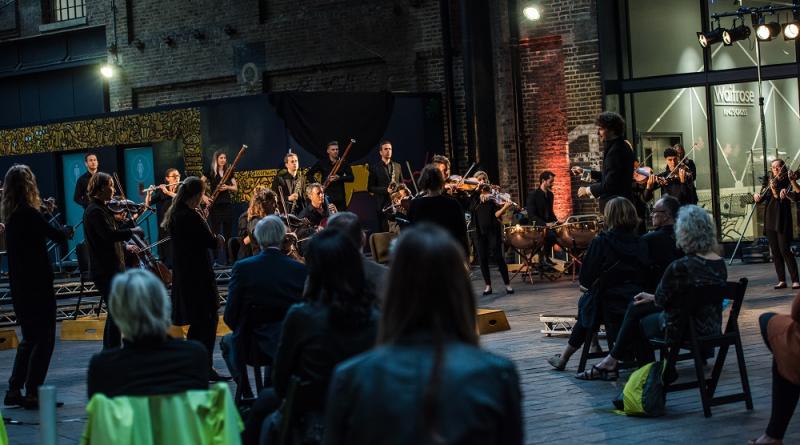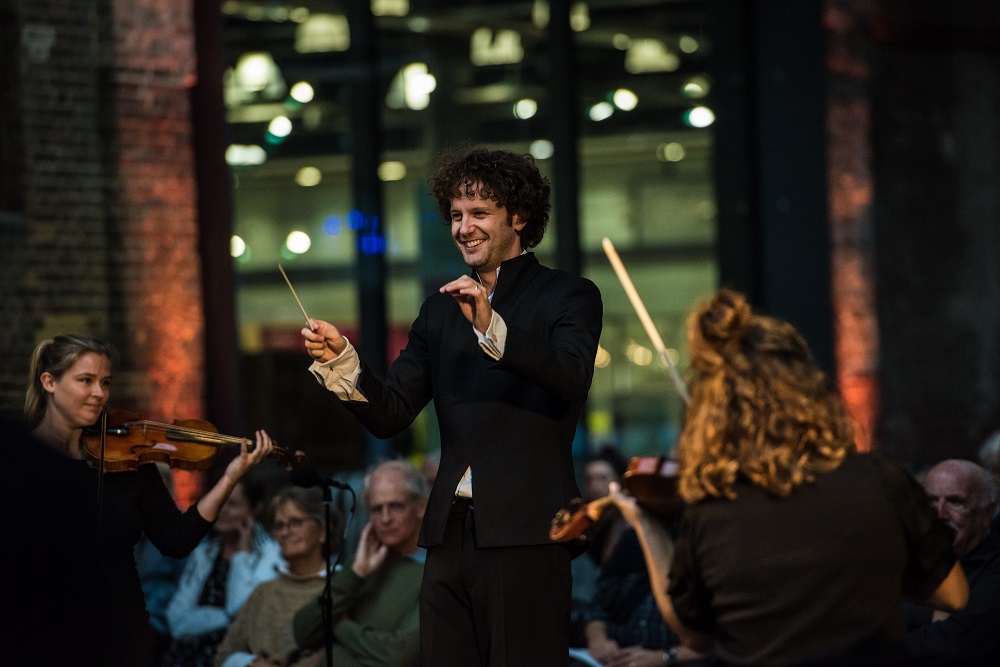Aurora Orchestra, Collon, West Handyside Canopy review – energy blasts outside Kings Cross Waitrose | reviews, news & interviews
Aurora Orchestra, Collon, West Handyside Canopy review – energy blasts outside Kings Cross Waitrose
Aurora Orchestra, Collon, West Handyside Canopy review – energy blasts outside Kings Cross Waitrose
First big UK symphony performance to an audience since lockdown - from memory

Blessed are the players and musical organisations who adapt and innovate, for they shall inhabit the post-lockdown landscape. And while we appreciate the difficulties any orchestra faces in terms of re-opening logistics and costs, livestreams have their limit.
Even the thrill this audience member got from the first A major chord of Beethoven’s most energetic symphony, the Seventh, was worth a hundred online experiences. There was even a Promming element; as passers-by, many with their Waitrose shopping, noted with surprise what was going on, and while some sped by as if this were not the remarkable happening it undoubtedly was, many stood at the side to hear the whole thing. All players who could stood, too, which always ups the energy. Beethoven, as the Aurora's main man Nicholas Collon (pictured below) observed in his spoken introduction, has had his anniversary year partly scuppered, though it's worth noting that an awful lot of him surfaced right up to 15 March, the last day of concert life as we knew it, when Esa-Pekka Salonen and the Philharmonia recreated the mammoth 1808 spectacular featuring so many of his works. The composer would surely have loved this big bang of back-to-business.  Inevitably circumstances made it more a total experience than a chance to really assess what kind of an interpretation this was from Collon, how the interplay of score-free players actually worked. That will be Jessica Duchen’s task when the performance hits an (audience-less) Albert Hall for the Aurora’s Thursday Prom. The funnel-shaped covered walkway between St Martin’s College of Art and the supermarket renders the sound both reverberant and very loud. Woodwind tone could be piercing. Climactic moments like the reiterated pounding at the heart of the first-movement development and the thunderous turns of the screw in the finale stood out in dance-revels which you might like to hear rendered in crisper focus; the soft lower strings at the start of the Allegretto, the subsequent long-term crescendo and the high, bright articulation of the scherzo worked best.
Inevitably circumstances made it more a total experience than a chance to really assess what kind of an interpretation this was from Collon, how the interplay of score-free players actually worked. That will be Jessica Duchen’s task when the performance hits an (audience-less) Albert Hall for the Aurora’s Thursday Prom. The funnel-shaped covered walkway between St Martin’s College of Art and the supermarket renders the sound both reverberant and very loud. Woodwind tone could be piercing. Climactic moments like the reiterated pounding at the heart of the first-movement development and the thunderous turns of the screw in the finale stood out in dance-revels which you might like to hear rendered in crisper focus; the soft lower strings at the start of the Allegretto, the subsequent long-term crescendo and the high, bright articulation of the scherzo worked best.
Yet all these varying levels of success were rendered insignificant in the general joy shared by young performers so obviously delighted to be playing together and a wildly enthusiastic audience. The soul was truly fed, as it can only be in a live event; the proof was in the enterprise. Much more of this, please.
rating
Explore topics
Share this article
Add comment
The future of Arts Journalism
You can stop theartsdesk.com closing!
We urgently need financing to survive. Our fundraising drive has thus far raised £49,000 but we need to reach £100,000 or we will be forced to close. Please contribute here: https://gofund.me/c3f6033d
And if you can forward this information to anyone who might assist, we’d be grateful.

Subscribe to theartsdesk.com
Thank you for continuing to read our work on theartsdesk.com. For unlimited access to every article in its entirety, including our archive of more than 15,000 pieces, we're asking for £5 per month or £40 per year. We feel it's a very good deal, and hope you do too.
To take a subscription now simply click here.
And if you're looking for that extra gift for a friend or family member, why not treat them to a theartsdesk.com gift subscription?
more Classical music
 Kempf, Brno Philharmonic, Davies, Bridgewater Hall, Manchester review - European tradition meets American jazz
Bouncing Czechs enjoy their Gershwin and Brubeck alongside Janáček and Dvořák
Kempf, Brno Philharmonic, Davies, Bridgewater Hall, Manchester review - European tradition meets American jazz
Bouncing Czechs enjoy their Gershwin and Brubeck alongside Janáček and Dvořák
 Solomon, OAE, Butt, QEH review - daft Biblical whitewashing with great choruses
Even a top soprano and mezzo can’t make this Handel paean wholly convincing
Solomon, OAE, Butt, QEH review - daft Biblical whitewashing with great choruses
Even a top soprano and mezzo can’t make this Handel paean wholly convincing
 Two-Piano Gala, Kings Place review - shining constellations
London Piano Festival curators and illustrious friends entertain and enlighten
Two-Piano Gala, Kings Place review - shining constellations
London Piano Festival curators and illustrious friends entertain and enlighten
 Echo Vocal Ensemble, Latto, Union Chapel review - eclectic choral programme garlanded with dance
Beautiful singing at the heart of an imaginative and stylistically varied concert
Echo Vocal Ensemble, Latto, Union Chapel review - eclectic choral programme garlanded with dance
Beautiful singing at the heart of an imaginative and stylistically varied concert
 Scott, Irish Baroque Orchestra, Whelan, RIAM, Dublin review - towards a Mozart masterpiece
Characteristic joy and enlightenment from this team, but a valveless horn brings problems
Scott, Irish Baroque Orchestra, Whelan, RIAM, Dublin review - towards a Mozart masterpiece
Characteristic joy and enlightenment from this team, but a valveless horn brings problems
 Classical CDs: Voice flutes, flugelhorns and froth
Baroque sonatas, English orchestral music and an emotionally-charged vocal recital
Classical CDs: Voice flutes, flugelhorns and froth
Baroque sonatas, English orchestral music and an emotionally-charged vocal recital
 Kanneh-Mason, Britten Sinfonia, Shave, Milton Court - a grin and a big beaming smile
A pair of striking contemporary pieces alongside two old favourites
Kanneh-Mason, Britten Sinfonia, Shave, Milton Court - a grin and a big beaming smile
A pair of striking contemporary pieces alongside two old favourites
 theartsdesk at the New Ross Piano Festival - Finghin Collins’ musical rainbow
From revelatory Bach played with astounding maturity by a 22 year old to four-hand jazz
theartsdesk at the New Ross Piano Festival - Finghin Collins’ musical rainbow
From revelatory Bach played with astounding maturity by a 22 year old to four-hand jazz
 First Person: Manchester Camerata's Head of Artistic Planning Clara Marshall Cawley on questioning the status quo
Five days of free events with all sorts of audiences around Manchester starts tomorrow
First Person: Manchester Camerata's Head of Artistic Planning Clara Marshall Cawley on questioning the status quo
Five days of free events with all sorts of audiences around Manchester starts tomorrow
 Goldscheider, Brother Tree Sound, Kings Place review - music of hope from a young composer
Unusual combination of horn, strings and electronics makes for some intriguing listening
Goldscheider, Brother Tree Sound, Kings Place review - music of hope from a young composer
Unusual combination of horn, strings and electronics makes for some intriguing listening

Comments
Excellent review, and agree
Yes, I had no idea it was
Yes, I had no idea it was amplified. Just sounded like a reverberant mess they were making the best of. Probably best left to nature.